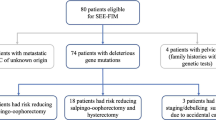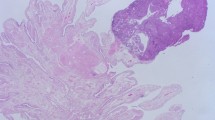Abstract
Background
High-grade serous carcinoma (HGSC) is the most common tubo-ovarian cancer. The fallopian tube harbours the precursor lesion: serous tubal intraepithelial carcinoma (STIC). Bilateral salpingo-oophorectomy is an effective risk-reducing surgical (RRS) strategy for breast cancer susceptibility gene mutation carriers (BRCAm). The value of RRS in those without defined genetic risk is unknown but these women represent a substantial cohort in prophylactic surgical practice.
Methods
This is a retrospective review of RRS at an Irish university teaching hospital.
Results
One hundred and thirty women underwent RRS; group 1 = 46 BRCAm; group 2 = 19 BRCAm negative/65 genetic status unknown. Group 1 had one occult HGSC. Group 2 had no STIC or cancers and were older and more likely to have hysterectomy and benign pathology. Other pathologies included serous tubal intraepithelial lesions (STIL) (2), p53 signatures (2), endometriosis (6), fibroids/adenomyosis (4) and atypical endometrial hyperplasia (1).
Conclusion
More than 60% of women undergoing RRS were BRCAm negative or untested. Counselling of high-risk women without defined germline mutations remains a challenge for gynaecologists because the likelihood of removing STIC lesions or occult invasive cancer is low. Removal of coincidental pathology may give added value to RRS in these women.
Similar content being viewed by others
References
Green AE, Garcia AA, Ahmed S (2014) Ovarian cancer. Available at: http://emedicine.medscape.com/article/255771-overview http://emedicine.medscap
Ovarian Cancer Statistics. National Cancer Registry Ireland. Available at: www.ncri.ie
Barnholz-Sloan JS, Schwartz AG, Qureshi F et al (2003) Ovarian cancer: changes in patterns at diagnosis and relative survival over the last three decades. Am J Obstet Gynecol 189(4):1120–1127. https://doi.org/10.1067/S0002-9378(03)00579-9
McCluggage WG (2011) Morphological subtypes of ovarian carcinoma: a review with emphasis on new developments and pathogenesis. Pathology 43(5):420–432. https://doi.org/10.1097/PAT.0b013e328348a6e7
Shih LM, Kurman RJ (2004) Ovarian tumorigenesis: a proposed model based on morphological and molecular genetic analysis. Am J Pathol 164(5):1511–1518. https://doi.org/10.1016/S0002-9440(10)63708-X
Koshiyama M, Matsumura N, Ikuo K (2014) Recent concepts of ovarian carcinogenesis: type I and type II. Biomed Res Int 93:461
Gross AL, Kurman RJ, Russell V, Shih LM, Visvanathan K (2010) Precursor lesions of high grade serous ovarian oarcinoma: morphological and molecular characteristics. J Oncol ID 126295
Erickson BK, Connor MG, Landen CN (2013) The role of the fallopian tube in the origin of ovarian cancer. Am J Obstet Gynecol 209(5):409–414. https://doi.org/10.1016/j.ajog.2013.04.019
Clarke BA, Crum CP, Nucci MR et al Protocol for the examination of specimens from patients with carcinoma of the fallopian tube. College of American Pathologists. Based on AJCC/UICC TNM, 7th edition, and FIGO 2006 Annual Report. Available at: http://www.cap.org
Poon C, Hyde S, Grant P, Newman M, Ireland Jenkin K (2016) Incidence and characteristics of unsuspected neoplasia discovered in high-risk women undergoing risk reductive bilateral salpingooophorectomy. Int J Gynecol Cancer 26(8):1415–1420. https://doi.org/10.1097/IGC.0000000000000791
National Cancer Institute (2014) Ovarian cancer screening (PDQ_). Available at: http://www.cancer.gov/cancertopics/pdq/screening/ovarian/healthprofessional/allpages
Jacobs IJ, Menon U, Ryan A, Gentry-Maharaj A, Burnell M, Kalsi JK, Amso NN, Apostolidou S, Benjamin E, Cruickshank D, Crump DN, Davies SK, Dawnay A, Dobbs S, Fletcher G, Ford J, Godfrey K, Gunu R, Habib M, Hallett R, Herod J, Jenkins H, Karpinskyj C, Leeson S, Lewis SJ, Liston WR, Lopes A, Mould T, Murdoch J, Oram D, Rabideau DJ, Reynolds K, Scott I, Seif MW, Sharma A, Singh N, Taylor J, Warburton F, Widschwendter M, Williamson K, Woolas R, Fallowfield L, McGuire AJ, Campbell S, Parmar M, Skates SJ (2016) Ovarian cancer screening and mortality in the UK collaborative trial of ovarian cancer screening (UKCTOCS): a randomised controlled trial. Lancet 387(10022):945–956. https://doi.org/10.1016/S0140-6736(15)01224-6
Cancer Genome Atlas Research (2011) Integrated genomic analyses of ovarian carcinoma. Nature 474(7353):609–615
Alsop K, Fereday S, Meldrum C, de Fazio A, Emmanuel C, George J, Dobrovic A, Birrer MJ, Webb PM, Stewart C, Friedlander M, Fox S, Bowtell D, Mitchell G (2012) BRCA mutation frequency and patterns of treatment response in BRCA mutation-positive women with ovarian cancer: a report from the Australian Ovarian Cancer Study Group. J Clin Oncol 30(21):2654–2663. https://doi.org/10.1200/JCO.2011.39.8545
Manchanda R, Abdelraheim A, Johnson M, Rosenthal AN, Benjamin E, Brunell C, Burnell M, Side L, Gessler S, Saridogan E, Oram D, Jacobs I, Menon U (2011) Outcome of risk-reducing salpingo-oophorectomy in BRCA carriers and women of unknown mutation status. Br J Obstet Gynaecol 118(7):814–824. https://doi.org/10.1111/j.1471-0528.2011.02920.x
Hartmann LC, Lindor NM (2016) The role of risk reducing surgery in hereditary breast and ovarian cancer. N Engl J Med 374(5):454–468. https://doi.org/10.1056/NEJMra1503523
Rocca WA, Gazzuola-Rocca L, Smith CY, Grossardt BR, Faubion SS, Shuster LT, Kirkland JL, Stewart EA, Miller VM (2016) Accelerated accumulation of multimorbidity after bilateral oophorectomy: a population-based cohort study. Mayo Clin Proc 91(11):1577–1589. https://doi.org/10.1016/j.mayocp.2016.08.002
NCCN Clinical practice guidelines in oncology. Genetic/familial high risk assessment: breast and ovarian. Updated 7th December 2016. Available at: http://www.nccn.org
SIGN Guidance. Number 135: management of epithelial ovarian cancer. Updated November 2013. Available at: http://www.sign.ac.uk
Domchek S, Friebel T, Neuhausen S, et al. (2011) Is hormone replacement therapy (HRT) following risk-reducing salphingo-oophorectomy (RRSO) in BRCA 1 (B1) and BRCA 2 (B2) mutation carriers associated with an increased risk of breast cancer? J Clin Oncol 29 suppl: abstr 1501
Powell CB, Chen LM, McLennan J et al (2011) Risk-reducing salpingo-oophorectomy (RRSO) in BRCA mutation carriers: experience with a consecutive series of 111 patients using a standardized surgical-pathological protocol. Int J Gynecol Cancer 21(5):846–851. https://doi.org/10.1097/IGC.0b013e31821bc7e3
Weinberger V, Bednarikova M, Cibula D, Zikan M (2016) Serous tubal intraepithelial carcinoma (STIC)—clinical impact and management. Exp Rev Anticancer Therapy 16(12):1311–1321. https://doi.org/10.1080/14737140.2016.1247699
Kwon J, Tinker A, Pansegrau G et al (2013) Prophylactic salpingectomy and delayed oophorectomy as an alternative for BRCA mutation carriers. Obstet Gynecol 121(1):14–24. https://doi.org/10.1097/AOG.0b013e3182783c2f
Mahon S, McFadden J, Gleeson N, O’Riain C (2016) Would fallopian tube tissue be left behind? Quantitation of tubal-type epithelium within ovary at time of risk reduction salpingo-oophorectomy—implications for ovary conserving strategies. Mod Pathol 29(S2):296A
Kamran MW, Vaughan D, Crosby D, Wahab NA, Saadeh FA, Gleeson N (2013) Opportunistic and interventional salpingectomy in women at risk—a strategy for preventing pelvic serous cancer (PSC). Eur J Obstet Gynecol Reprod Biol 170(1):251–254. https://doi.org/10.1016/j.ejogrb.2013.06.030
Mingels MJ, Roelofsen T, Van der Laak JA et al (2012) Tubal epithelial lesions in alpingo-oophorectomy specimens of BRCA-mutation carriers and controls. Gynecol Oncol 127(1):88–93. https://doi.org/10.1016/j.ygyno.2012.06.015
Vorwergk J (2014) Prophylactic bilateral salpingectomy (PBS) to reduce ovarian cancer risk incorporated in standard premenopausal hysterectomy: complications and re-operation rate. J Cancer Res Clin Oncol 140(5):859–865. https://doi.org/10.1007/s00432-014-1622-6
Polcher M, Hauptmann S, Fotopoulou C et al (2015) Opportunistic salpingectomies for the prevention of a high-grade serous carcinoma: a statement by the Kommission Ovar of the AGO. Arch Gynecol Obstet 292(1):231–234. https://doi.org/10.1007/s00404-015-3697-y
Venturella R, Lico D, Borelli M et al (2016) 3 to 5 years later: long-term effects of prophylactic bilateral salpingectomy on ovarian function. Minim Invasive Gynecol 13:S1553–S4650
Segev Y, Igbal J, Lubinski J, Hereditary Breast Cancer Study Group et al (2013) The incidence of endometrial cancer in women with BRCA 1 and BRCA 2 mutations: an international prospective cohort study. Gynecol Oncol 130(1):127–131. https://doi.org/10.1016/j.ygyno.2013.03.027
Pennington KP, Walsh T, Lee M, Pennil C, Novetsky AP, Agnew KJ, Thornton A, Garcia R, Mutch D, King MC, Goodfellow P, Swisher EM (2013) BRCA1, TP53, and CHEK2 germline mutations in uterine serous carcinoma. Cancer 119(2):332–338. https://doi.org/10.1002/cncr.27720
Mc Cluggage WG, Mc Manus DT, Lioe TF, Hill CM (1997) Uterine carcino-sarcoma in association with tamoxifen treatment. Brit J Obstet Gynaecol 104(6):748–775. https://doi.org/10.1111/j.1471-0528.1997.tb11992.x
Chlebowski R, Rohan T, Manson J et al (2015) Breast cancer after use of oestrogen plus progestin and oestrogen alone: analysis from 2 Women’s Health Initiative Randomised Clinical Trials. JAMA Oncol 1(3):296–305. https://doi.org/10.1001/jamaoncol.2015.0494
Author information
Authors and Affiliations
Corresponding author
Rights and permissions
About this article
Cite this article
Thompson, C., McCormick, C., Kamran, W. et al. Risk reduction surgery (RRS) for tubo-ovarian cancer in an Irish gynaecological practice: an analysis of indications and outcomes. Ir J Med Sci 187, 789–794 (2018). https://doi.org/10.1007/s11845-017-1717-6
Received:
Accepted:
Published:
Issue Date:
DOI: https://doi.org/10.1007/s11845-017-1717-6




